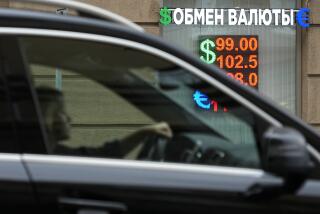Gorbachev Orders Ruble Devalued By 69% : Economy: He acts to force Soviet industry to become more productive and to squeeze state subsidies from prices.
MOSCOW — President Mikhail S. Gorbachev, moving Friday to implement his economic reforms, ordered devaluation of the Soviet currency, the ruble, by 69% in an effort to force the country’s industry to become more productive and to begin wringing state subsidies out of the price system.
In another major economic decree, Gorbachev authorized foreign companies to establish wholly owned subsidiaries in the Soviet Union on an equal footing with Soviet enterprises and with the right to reinvest or transfer their earnings abroad.
In a third decree, which also lays the foundation for the major changes ahead, Gorbachev permitted Soviet banks to increase the interest they pay on long-term deposits. The Finance Ministry and the Soviet State Bank immediately raised their maximum rates from 3% and 4% to 9% and 10%.
Prime Minister Nikolai I. Ryzhkov, speaking to a trade union congress, said more steps will quickly follow as Gorbachev introduces his long-delayed economic reforms, with the aim of building enough momentum to overcome likely resistance to the changes.
All three measures were included in the reforms approved in outline last week by the Supreme Soviet, the country’s legislature, to develop a market economy here in place of the old system of state ownership, central planning and bureaucratic management. Gorbachev signed them before leaving Friday for a visit to Spain.
The ruble’s devaluation is effective next Thursday for all commercial transactions.
Although endorsing step-by-step changes, Ryzhkov again argued against moving too boldly, too fast. He said the transition cannot be accomplished in 500 days, as advocated by radicals, but will require five to eight years of hard work.
He said price reform, a key element in developing a market economy here, will be undertaken gradually. Although virtually all wholesale prices will be raised, only 40% will be allowed to respond to market forces of supply and demand, he said. At the same time, retail prices on basic consumer goods will be maintained next year through state subsidies.
The devaluation of the ruble, which will be worth 56 cents instead of $1.81, is aimed at encouraging Soviet enterprises to export more goods and to discourage imports by making foreign goods more expensive, Ryzhkov said.
But the measure will also begin the process of rationalizing the Soviet price system, essential to fundamental economic reforms, by squeezing out some of the subsidies that have long been hidden in the complex system of “coefficients”--in effect, more than 2,000 separate exchange rates, used in financing Soviet imports and exports.
According to government estimates, about 90% of Soviet exports will be “profitably priced” at the new commercial rate.
The devaluation will be followed in January by more moves to develop a regular foreign-exchange market. This is part of the long process of making the ruble a convertible currency that can be bought and sold on international markets and used to purchase Soviet goods or to invest here.
But even at 56 cents, less than a third of its previous official value, the ruble is still badly overpriced.
Tourists can now buy rubles officially for 18 cents each, and black market dealers here and banks abroad buy and sell rubles at 5 to 7 cents each. For expensive imports, such as videocassette recorders and computers, a ruble is often worth no more than 3 cents.
Gorbachev’s decree permitting full foreign ownership of enterprises is aimed at attracting investment from Western companies, many of which have insisted on complete ownership and management control of any subsidiary.
Until now, foreign companies were forced to form joint ventures with Soviet partners, who until recently held at least 51% of the shares, and to make barter deals to take out their profits.
The decree does not say how profits can be repatriated, leaving that to later legislation. It also stops short of permitting foreign firms to buy land, permitting long-term leasing instead.
But it does promise that “foreign investments on Soviet territory enjoy legal protection, and their conditions cannot be less favorable than those existing for the property of Soviet enterprises, organizations and citizens.”
“Profits of foreign investors, obtained in the Soviet Union in Soviet currency, can be freely reinvested and used on Soviet territory . . . “ according to the decree.
Some Western firms offering goods and services for local purchase, such as McDonald’s, Pizza Hut, Estee Lauder and Benetton, are earning large amounts of rubles that, until now, have had to be spent in the Soviet Union. The new currency market envisioned by the decree devaluing the ruble may be one way to convert local earnings into U.S. dollars, German marks or other hard currencies.
Taken together, the devaluation and new rules on foreign investment are likely to encourage Western companies to enter the Soviet consumer market, which has been woefully undersupplied.
The increase in interest rates is meant to absorb more of the hundreds of billions of rubles of personal savings, using it to finance the government’s huge deficit and reducing inflation by taking it out of the Soviet economy.
Official estimates put inflation at 8% to 9% a year, but non-government economists put it at nearly 80% when black-market prices are taken into account.
More to Read
Sign up for Essential California
The most important California stories and recommendations in your inbox every morning.
You may occasionally receive promotional content from the Los Angeles Times.










